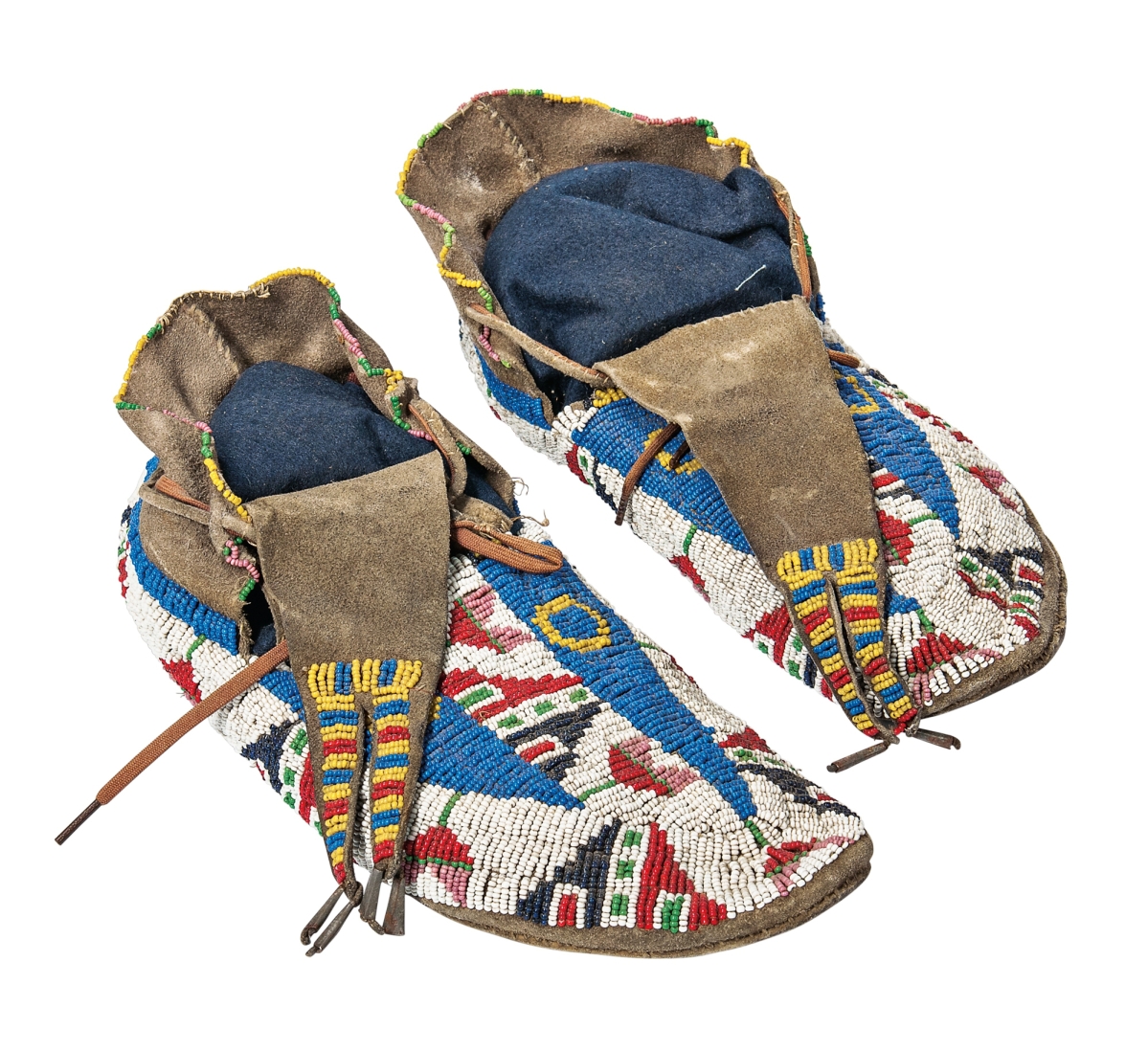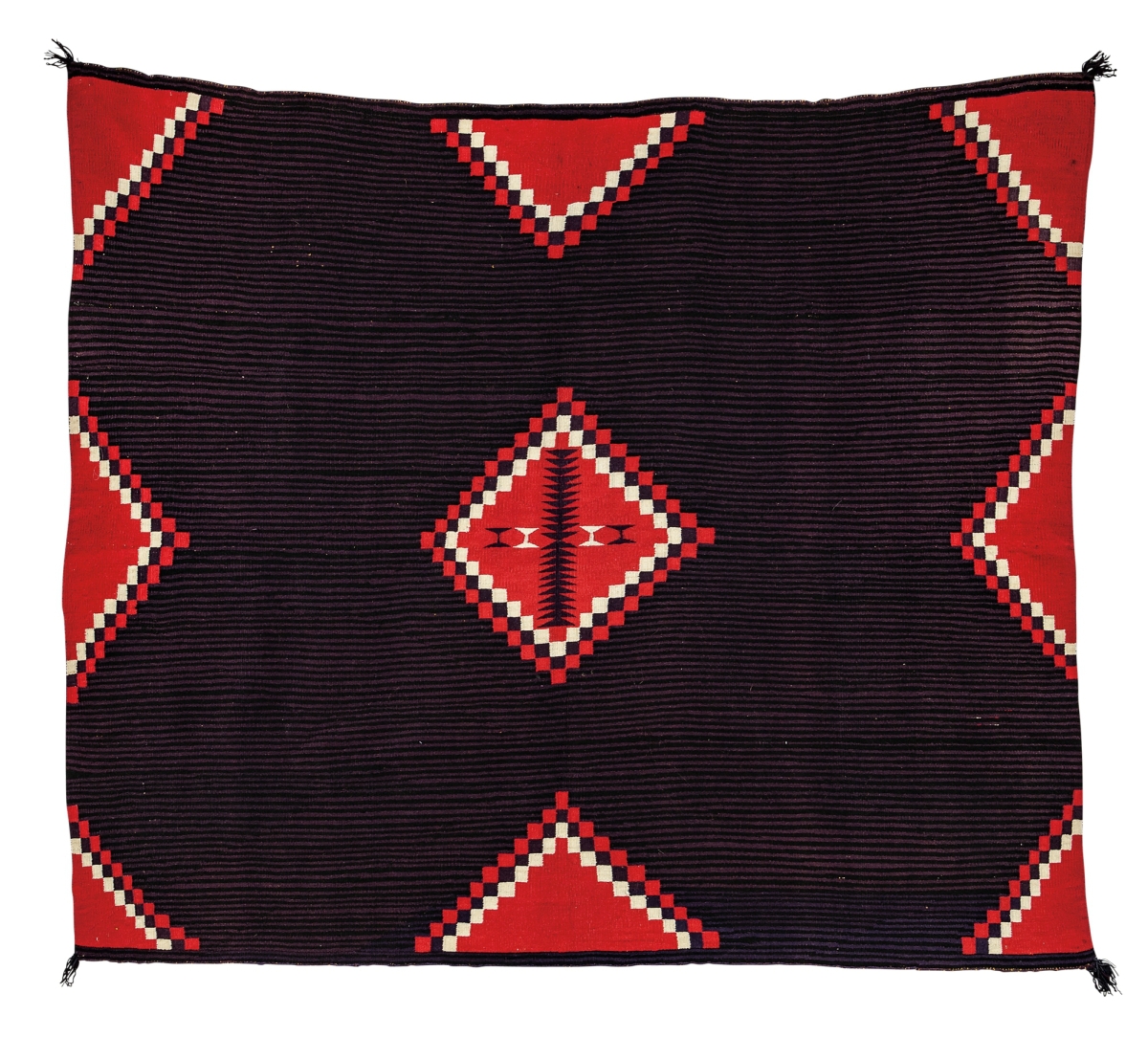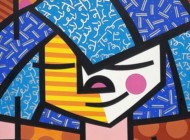
The highest priced lot in the sale, bringing $46,125, way over the estimate, was a late Nineteenth Century Eskimo carved mask with two faces, cut-out eyes, nostrils and teeth. The underbidder had this to say: “This mask was really ART — be sure to use capital letters for that. Some items are routine and some are interesting. Rarely is one ART, and that’s why I wanted this one.”
Review and Onsite Photos by Rick Russack, Additional Photos Courtesy of Skinner, Inc
BOSTON – On Saturday, May 18, Skinner offered over 550 lots of Native American material from the collection of Jim Grievo and his wife, Sheryl.
The breadth and depth of the collection, in terms of quality, condition, variety and geographical representation, was impressive. With few exceptions, there was not just one of anything – there were numerous examples of nearly everything: over 100 lots of baskets, over 120 lots of jewelry – some lots with up to ten pieces – over 60 lots of beaded objects, numerous pipes, numerous weavings, etc.
Grievo is well known as a dealer selling folk art, American furniture, Native American items and other Americana, which he has been doing for close to 50 years. Not so well known is the fact that he and his wife also personally collected both Americana and Native American pieces. In 2012, Pook and Pook sold the couple’s folk art and Americana collection for more than $2 million. At that time, Grievo said that they would “probably” continue to add to their Native American collection, which they did.
The Native American collection sold for a few dollars under $775,000, including post-sale transactions. With 508 lots sold, there is additional post-sale interest in several more. Just about half of the lots, 274 to be precise, sold to online bidders. As always, the exceptional items brought far higher prices than expected, as competition was strong for those items.
At the time of the Pook and Pook sale, Grievo discussed his introduction to the antiques business, and his career, with an online antiques publication. It began in 1971 after graduating from college and not easily finding a job. He started buying at local tag sales, selling the stuff and making a profit. Then buying at local auctions, and then he eventually found his way to Brimfield, when it was just the Gordon Reid field. Color and original surface became deciding factors when considering an object. He started doing shows, like the Jim Burk York shows, and went on from there.
Discussing the building of the Native American collection, he recently said, “I’ve been buying Native American pieces for years; probably starting about 40 years ago. I really got serious about the collection over the last ten years or so, after the Pook sale. Much of the stuff we have was bought locally and has never been on the market before.”

A piece of ART, with capital letters, and the highest priced beadwork item in the sale, this colorful Kiowa beaded cloth and hide model cradle, in various shades of blue, circa 1890, sold for $19,680.
The two highest priced items in the sale, each exceeding estimates, were carved wooden masks. The highest priced example, estimated at $4/6,000 but bringing $46,125, was a late Nineteenth Century Eskimo carved mask with two faces, cut-out eyes, nostrils and teeth. It was made by the Yupik peoples of Alaska, who lived in the area of the Bering Sea. It was bought by a phone bidder, underbid by New Mexico dealer/collector Robert Vandenberg, in the room. Vandenberg was asked what made this mask so desirable. “This mask was really ART – be sure to use capital letters for that. Some items are routine and some are interesting. Rarely is one ART, and that’s why I wanted this one,” he said.
Bringing the second highest price of the sale was a very colorful circa 1930s Tlingit mask, which sold for $22,140, at least partly because of the importance of the carver. It had an old label attached that said “this mask was carved by a son of Chief Anablahash of the Taku tribe of the N.W. Coast Tlingits. He was the master carver of one of the Douglas Island Clans. He was in his nineties when this mask was purchased from the Nugget Shop of Juneau, Alaska in the 1940s or 1950s. The mask’s usage was ceremonial, very rare.”
Interestingly, the item that was expected to bring the highest price of the sale was also a mask but it did not sell. It was done by the Nuu-chah-nulth, peoples, in the late Nineteenth Century. It was estimated at $30/40,000. A few days after the sale, Grievo said, “that really surprised me. It was great and I’ve owned it about 40 years. I was offered $50,000 for it. You never know what will happen at an auction but I’m delighted to be getting it back.”
Two of the next highest prices were achieved by Plains Indian beaded objects. A colorful Kiowa beaded cloth and hide model cradle, in various shades of blue, circa 1890, sold for $19,680. Again, a piece of art. Bringing a few dollars less, $17,220, was a Lakota pipe bag, circa 1870, which was beaded on both sides. It had a variety of patterns, including a horse, morning stars and more. There were several other model (or toy) cradles as well as a full-size Cheyenne beaded hide example from the early Twentieth Century, which brought $1,968. Plateau beadwork included a late Nineteenth Century cloth flat bag, decorated on one side, which realized $1,845.
Unquestionably, Jim and Sheryl Grievo liked Southwestern jewelry. There was a lot of it, the selection was comprehensive and the quality was high.
Grievo said, “I learned about the jewelry when I handled a large estate. By handling all that, I learned what was better and earlier. To learn about anything, you need to see and handle a lot of it. The bracelets were the primary thing that I really liked, so I pursued them all over: Brimfield, Renningers, Shupp’s Grove, everywhere I went I would buy them. It’s mostly of the earlier period, 1910-30, and much of it is made from melted down silver ingots, which is nice.”

Was this ledger drawing done by Sitting Bull? It has his name on it. Jim Grievo said that he has owned it “for quite a while and I’ve always believed it to be what it purported to be.” But he said there was some controversy over whether it was actually done by Sitting Bull. Apparently bidders agreed with Grievo as it sold for $15,590.
There were more than 120 lots of jewelry in the sale, several of which included as many as ten pieces. This was especially true of the bracelets, which numbered to about 200 pieces. A lot of two Navajo silver and turquoise bracelets from the second quarter Twentieth Century included a wide silver band with nine graduated turquoise stones, complex stampwork with two applied snakes and the two earned $2,214, well over the estimate.
Dozens of other lots sold within the same general price range. There were also numerous Southwest silver and turquoise concha belts. A lot of two mid-Twentieth Century examples, one with nine stamp-decorated conchas on a narrow leather belt with four turquoise stones on the buckle, the second with eight conchas and seven butterfly spacers, each with a turquoise stone in the center, sold for $3,444, again, well over the estimate. Zuni silver pieces inlaid with stone, did well. A silver box, about 6 by 6 inches and inlaid with a snake dancer on the lid, realized $4,920, well over the estimate.
Grievo discussed a ledger drawing that was signed “Sitting Bull” that did well. He said, “I’ve owned that for quite awhile and always believed it was right. But it’s been a controversial piece. Some people who saw it did not believe that it was done by Sitting Bull. When it came time to put an estimate on it for the sale, we decided to go low, and used $4/6,000. My feeling was that people could make their own decision about it, but it seems that most agreed that it was done by Sitting Bull.” It realized $15,590.
If there was any softness, it was in the baskets, of which there were more than 100 lots, many with multiple examples. Several of the basket lots sold below estimates. Prior to the sale, Mike Evans, the department head, said, “Jim had a really good group of California baskets, including Panamints.” A pictorial Panamint with a floral motif, lizards and more led that particular group, finishing at $3,075. Some of the Panamints did not sell during the sale but were sold a few days later. Grievo said, “California baskets were one of the first things I collected. The weaving and the designs really appealed to me.” A finely woven Apache pictorial olla, circa 1900 with animal and human motifs, was the most sought-after of the basket offerings, finishing at $6,765.
Grievo’s final comment was: “I don’t know what it is, but all through my life, even with the Americana sale, I bought the stuff that I loved and moved me. The stuff that had design and quality, I could always pick up on it.”
After the sale, Mike Evans, the department head, said that the gross, $775,000, was about $100,000 above the low estimate. “That makes it a good sale and says to me that we got it right. I was a little disappointed with the results for the baskets. Jim had a good eye for the baskets, but I thought the prices were soft. The jewelry did well and the pipes might have done better. But, all in all, it was a good sale.”
For additional information, www.skinnerinc.com or 617-350-5400.





















.jpg)








